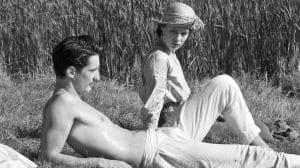
François Ozon uses a lot of obvious techniques with his new movie Frantz. The movie is shot primarily in black-and-white with color interludes, and the story features a major plot twist that completely alters its direction.
If you’ve seen Maurice Rostand’s 1930 play The Man I Killed (L’homme que j’ai tué) or Ernst Lubitsch’s 1932 English language movie adaptation Broken Lullaby, you’ll know where this is headed, but Ozon, who gave us 8 Women and Swimming Pool, comes up with an intriguing angle on the previous tale.
Whereas the previous source material was made in the wake of World War I and looked at the madness that occurred with understandable sorrow and outrage, Ozon includes several subtle hints at why we learn so little from our lethal mistakes.

“..Frantz is at its best when Ozon briefly pauses the main story.”
Set in Quedlinburg, Germany, Frantz begins after the Versailles Treaty has been signed. The emotional and physical wounds from the Great War are still fresh, so Anna (Paula Beer) finds it odd to see newly cut flowers placed on the grave of her fiancé.
The person responsible seems equally unlikely. He’s a struggling French musician named Adrien Rivoire (Pierre Niney). The villagers dislike him simply because he was on the other side of the war, but he tells Anna and Frantz’s aging parents (Ernst Stötzner and Marie Gruber) that he knew their son before the war and is a violinist like he was.
Because Frantz did study in Paris before the conflict, Adrien reveals things about him that people in Quedlinburg were unaware of. He and Anna gradually become close, and it’s easy to wonder if Frantz and Adrien were more than buddies before 1914.
The big reveal is something of a letdown, but Frantz is at its best when Ozon briefly pauses the main story. While Adrien is getting to know the people close to Frantz, the late soldier’s father is having discussions with other villages who share his anger about the war and want to do more than grieve the loss of their sons.

“Grief and desperation can make even the most vile and ludicrous ideas seem wise.”
In these brief moments, it’s easy to see why Nazism was so appealing. The words “national socialism” or Hitler are never mentioned, but the mindset that led to them is clearly visible. Grief and desperation can make even the most vile and ludicrous ideas seem wise.
At first, Pascal Marti’s monochrome cinematography (which won a César, or French Oscar) seems like a gimmick, but in watching the performances, Orson Welles’ adage about black-and-white being “the actor’s friend” is proven over and over. Adrien’s discomfort at being in the house where Frantz grew up. It’s easier to spot Niney’s facial muscles trying to keep up a strained smile when gaudy objects in the background aren’t around to distract us.
With all the complicated emotions involved, it’s easy to see why Ozon uses color sparingly. Color shows up primarily during flashbacks, but Marti mutes the hues, leading the viewer to wonder if these scenes are merely wishful thinking.
If The Man I Killed reminds viewers why it’s essential to reconcile even after something as terrible as the Great War, Frantz lets them know why it’s so difficult.

Frantz (2016) Directed by François Ozon Written by François Ozon and Philippe Piazzo, based on the play The Man I Killed by Maurice Rostand. Starring: Pierre Niney, Paula Beer, Ernst Stötzner, Marie Gruber, Johann von Bülow, Anton von Lucke
7 out of 10

